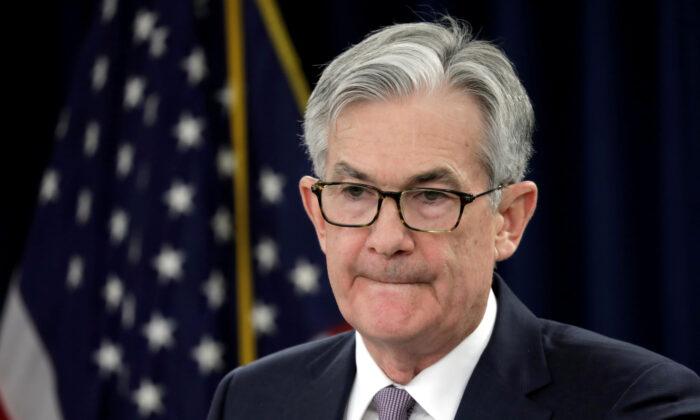Commentary
Pity Federal Reserve Chair Jay Powell.
He faces a vastly different economic tableau in what will be his second term than he did for most of his first term. The policy options to fulfill the Fed’s dual mandates—maintaining price stability and full employment—are more at odds now than they have been at any time since the 1980s.
Powell took the helm of the central bank in 2017, when interest rates were recovering from
historically low levels, the near Zero Interest Rate Policy, or “ZIRP,” that had been implemented by his predecessor, Ben Bernanke, amid the 2008 financial crisis.
As the CCP (
Chinese Communist Party) virus, commonly known as the novel coronavirus, spiked rates and nearly seized up the commercial paper markets in March 2020, Powell implemented the Fed’s
Secondary Market Corporate Credit Facility (SMCCF), by which the Fed bought bonds and ETFs, and implemented other measures to maintain liquidity. SMCCF purchases ended in December 2020.
In June 2020, as short-term rates were again nearing zero, Powell implemented the Fed’s asset purchase program, whereby the Fed bought at least $80 billion in Treasurys and $40 billion in mortgage securities every month; in order to keep long-term rates low, stimulate long-term capital investment and the housing market, and signal businesses that the other rates on which they rely would remain low.
But now inflation, as measured by the Consumer Price Index, is at
6.2 percent year-on-year for October, more than three times above the Fed’s 2 percent inflation target. (The Fed’s preferred measure of inflation, the
Personal Consumption Expenditure Index, printed at 5 percent and 4.1 percent, excluding food and fuel.)
Beyond price stability, though, Powell is also challenged by an anemic labor participation rate. Although unemployment printed at just 4.2 percent in November—in the range of what is generally accepted to be “full employment”—the labor participation rate is just 61.8 percent, down 150 basis points from the pre-pandemic level of 63.3 percent.
There lies Powell and the Fed’s quandary: to control inflation, the Fed must raise rates. But to maintain full employment, and hopefully coax more workers into the labor force, it helps to have low interest rates.
Assuming the Omicron variant of the CCP virus is less virulent and less dangerous than the Alpha variant that struck in 2020, and that the “Blue State” rent and mortgage payments expire as planned, it’s reasonable to assume workers waylaid by the pandemic will return to the workforce and the labor participation rate will start to increase, probably by the second quarter of next year. It should pick up steadily for the balance of the year. So-called “demand-pull inflation”—too few goods and workers’ wages bidding up prices which tend to be transitory—will likely be subsumed as supply chains and the workforce return, albeit with continuing higher prices, around this time.
But the Fed is still likely to continue its near ZIRP with interest rates, so prices will continue to escalate. While the Fed is already on the way to reducing its asset purchase program, (so-called “tapering”), and Powell stated in testimony before the Senate Banking Committee Tuesday that the Fed may accelerate the reduction of tapering at its December meeting, he gave no indication in his testimony that he would reduce the shorter term rates that the Fed traditionally manages. Moreover, Powell is on record as saying the
Fed will not sell SMCCF, Treasury, and mortgage assets, so the money supply added to the system by those facilities will remain.
With M2, the accepted measure of the money supply,
more than a third above pre-CCP virus, levels, and M2 velocity only
slightly higher than it was at the height of the pandemic in the second quarter of 2020, when it was the lowest on record, the system is literally awash in cash with nowhere to go. Inflation—and likely bubbles—will result in equities, real estate, cryptos and non-fungible tokens (NFTs.) So inflation—“always and everywhere a monetary phenomenon,” according to Milton Friedman—will continue, turbocharged by Democrats in Congress who wish to pump another two trillion of federal spending into the economy while simultaneously putting a brake on private investment and job creation by raising taxes. Powell is unlikely to rein in the money supply because it would slow the economy and reduce consumer spending, usually the biggest element of GDP growth.
But choosing between the “yin” of price stability and the “yang” of full employment are not all of Powell’s challenges.
While the Fed keeps pumping cash into the inflation balloon, Sen. Elizabeth Warren (D-Mass.), a member of the Senate Banking Committee, correctly pointed out in Powell’s testimony Tuesday that there are large, highly influential private equity players like BlackRock that resemble
“SIFIs,” or Systemically Important Financial Institutions, large market participants that can imperil the entire financial system and broader economy when they get “out over their skis,” as the Lehman Brothers did in 2008. SIFIs came under closer federal regulation under Section 805 after the 2010 passage of the Dodd-Frank Act (
Public Law 111-203). Warren also expressed concerns about cryptos, which are now also mostly unregulated and play an increasingly significant role in private investments. SIFIs or near SIFIs outside the parameters of federal regulation all create considerably more risk to the markets than have existed in living memory.
Like I said, pity Jay Powell. He faces the inflation challenges of former Fed Chair Paul Volcker in 1980 with the systemic economic risks of Fed Chair Ben Bernanke in 2008—at the same time.
Investors—and everyday Americans—should all hope he’s up to the job.





